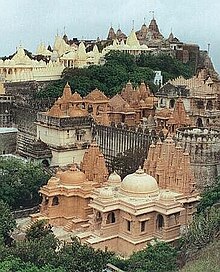| Shatrunjaya Tirtha, Palitana | |
|---|---|
Pundarikgiri | |
 | |
| Religion | |
| Affiliation | Jainism |
| Sect | Śvetāmbara |
| Deity | Rishabhanatha |
| Festivals | Mahavir Janma Kalyanak, Kartik Purnima & Falgun Feri |
| Governing body | Anandji Kalyanji Trust |
| Location | |
| Location | Palitana, Bhavnagar district, Gujarat, India |
| Geographic coordinates | 21°28′58.8″N 71°47′38.4″E / 21.483000°N 71.794000°E |
| Specifications | |
| Temple(s) | 863 |
| Monument(s) | 2700 |
| Elevation | 603 m (1,978 ft) |
| Part of a series on |
| Jainism |
|---|
 |
The Palitana temples, often known only as Palitana, are a large complex of Jain temples located on Shatrunjaya hills near Palitana in Bhavnagar district, Gujarat, India. Also known as "Padliptapur of Kathiawad" in historic texts, the dense collection of almost 900 small shrines and large temples have led many to call Palitana the "city of temples".[1] It is one of the most sacred sites of the Śvetāmbara tradition within Jainism. The earliest temples in the complex date as far back as the 11th century CE.[2]
The Palitana temple complex is near the top of the hill, in groups called Tonks (Tuks) along the hills' various ridges.[1] The main temple is dedicated to Rishabhanatha, the first Tirthankara; it is the holiest shrine for the Śvetāmbara Murtipujaka sect. Marble is the preferred material of construction. More than 400,000 pilgrims visited the site in 2010.[3]
Jains believe that 23 of the 24 Tirthankaras, all except Neminatha, sanctified Palitana with visits. This makes the site particularly important to the Jain tradition. These temples are reached by most pilgrims and visitors by climbing around 3500 stone steps along a hilly trail. Some hire pallanquins at the base of the hills, to be carried to the temple complex. Palitana, along with the Shikharji in Jharkhand, is believed to be the holiest of all pilgrimage places by the Jain community.[4][5]
Digambara Jains have only one dedicated temple in Palitana.[6] Hingraj Ambikadevi (known as Hinglaj Mata) is considered as the presiding deity of the hill, who is a Jain Yakshini (attendant deity).[7] As the temple complex was built to be an abode for the divine, no one is allowed to stay overnight, including the priests.[8]
- ^ a b Burgess & Spiers 1910, p. 24.
- ^ James Burgess (1977). The Temples of Palitana in Kathiawad. South Asia Books. ISBN 978-0-8364-0021-2.
- ^ Hardenberg 2010, p. 2.
- ^ "Jains". www.philtar.ac.uk. Archived from the original on 13 October 2007.
- ^ John E. Cort, Framing the Jina: Narratives of Icons and Idols in Jain History, p.120. Oxford University Press (2010). ISBN 0-19-538502-0
- ^ Peter 2010, p. 352.
- ^ Suriji 2013, p. 31.
- ^ "Palitana Temples". Government of Gujarat. Archived from the original on 26 December 2017. Retrieved 26 December 2017.
